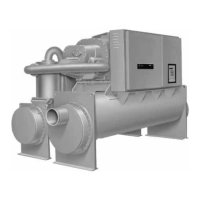Temperature Sensors
RTHC-SVD01B-EN 15
Section 3 Temperature Sensors
3-1. General
All of the temperature sensors used on UCP2 are negative tempera-
ture coefficients (NTC) thermistors and located in thermal wells. The
thermistors all have a base resistance of 10 Kohms at 77 F (25C) and
display a decreasing resistance with an increasing temperature. UCP2
reads the temperature by measuring the voltage developed across the
thermistors in a voltage divider arrangement with a fixed internal resis-
tance. The value of the “pull-up” resistor is different depending on the
temperature range where the most accuracy is desired. The voltage
source for this measurement is a closely regulated 5.0 VDC supply.
An open or shorted sensor will cause UCP2 to indicate the appropriate
sensor. In most cases, an open or short will cause a MMR diagnostic
that will result in a machine shutdown.
3-2. Sensor Checkout Procedure
All temperature sensors on the RTHC units are in thermal wells. Cycle
the chiller off prior to testing the sensors.
1. Remove the sensor of concern from the thermal well.
2. Place the sensor, while still connected to the UCP2, in an ice
bath.
3. Monitor the UCP2 and record which sensor reading approaches
32 F.
4. With the sensor in an ice bath, the read-out on the front panel dis-
play should approach 32 F.
5. If the sensor is wired correctly but does not approach 32 F follow
the steps below.
6. Re-install the sensor in the well with a suitable heat transfer
paste.
NOTE: Heat transfer paste must be used on all sensors for an accu-
rate reading.
7. Measure the temperature at the sensor with an accurate ther-
mometer.
8. Record the temperature reading observed.
9. With the sensor leads connected to UCP2 and UCP2 powered,

